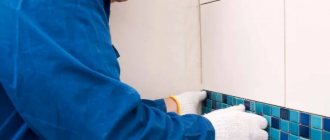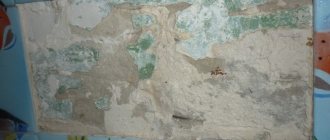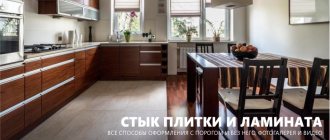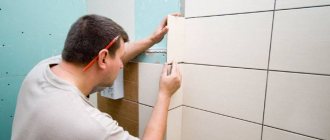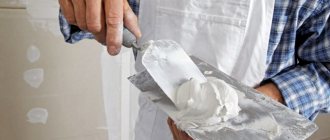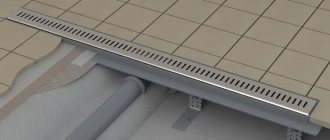Tile floors are beautiful and practical. Such surfaces are easy to care for. They are very aesthetically pleasing and can withstand moisture well. However, it is moisture that accidentally forms on such a coating that can cause falls and injuries. To avoid an accident, it is necessary to use an anti-slip coating.
Anti-slip frost-resistant tiles - what are they?
This tile has a number of features that ensure its good performance.
The resistance to low temperatures of this material is due to its low hygroscopicity, because it does not absorb moisture, which can destroy the structure. A low level of hygroscopicity is achieved due to the fact that frost-resistant anti-slip tiles are pressed under high pressure during the production process. According to the technology in the manufacture of this material, the mixture must be compressed as much as possible under high pressure in order to eliminate all voids.
To produce the material, in most cases, granite chips, porcelain stoneware, special glue and a mixture with plasticizers are used. Thanks to this, the composition (unlike clay) does not absorb moisture. Unlike other materials, such tiles are not only glazed on the outside, but also on the back. At the same time, the outer part has a more attractive decorative appearance.
The anti-slip properties of the surface are due to a special processing method. The grinding stone used for processing allows you to achieve a rough surface. Thanks to this, pronounced anti-slip properties are achieved. Non-slip porcelain tiles are much better than paving slabs because... it provides long service life and ease of use. The high price of the material is its biggest disadvantage.
Glue selection
Adhesion will allow you to reliably stick tiles onto tiles
Adhesion strength of different surfaces.
above 1 MPa . Such adhesive compositions include Laparet Titan and Monolith adhesives. Monolith glue has an adhesion parameter Adhesion
Strength of adhesion of different surfaces.
(C) is equal to 1.4 MPa , for Titan this parameter reaches 1.8 MPa . This means that with the help of such adhesive mixtures you can glue not only tiles, but also porcelain stoneware onto old tiles.
You can find out the characteristics of adhesive compositions on the manufacturer’s website or on the packaging. The parameter for glue consumption per 1 m² is also indicated here. For Monolith glue this parameter is 1.4 m², for Titan glue – 1.3 m². Knowing this parameter, you can easily find out the glue consumption by multiplying the glue consumption by the surface area of the cladding.
Peculiarities
Modern frost-resistant tiles with an anti-slip surface are very popular and in demand. The relevance of this finish is due to the many positive characteristics that are inherent in it.
- The main advantage of frost-resistant and anti-slip tiles is their high strength characteristics. Such material is not subject to destruction and mechanical damage. High-quality tiles that are not afraid of frost will remain intact and unharmed even under the influence of very serious loads.
- The cladding material in question is durable. High-quality anti-slip and frost-resistant tiles can last for many years, remaining as reliable and attractive as when they were first used.
- This lining is not subject to abrasion and is wear-resistant. Coupled with increased strength, such characteristics make anti-slip tiles an indispensable material.
- Under the influence of low temperatures, the material does not deteriorate, does not crack, and does not lose its visual appeal. High-quality frost-resistant tiles will remain beautiful and quite strong even in harsh winters. Simple tiles intended for interior decoration cannot boast of such qualities.
- It is very difficult to slip on the non-slip coating of frost-resistant tiles. This feature of the material turns out to be relevant when it comes to the winter period, because at this moment the risk of falling on the tiled base is very high.
- Modern frost-resistant tiles look attractive. On sale you can find examples that will give a simple porch a truly chic appearance.
- The range of such finishing materials is huge and is constantly updated with new updated items.
Frost-resistant and anti-slip tiles designed for finishing the porch have many advantages. No serious shortcomings were noticed in such materials.
However, very often branded cladding is quite expensive and can cost the buyer a tidy sum, especially if it is necessary to decorate a large porch.
Caution, wet floor
The cause of misunderstandings and falls on a tile floor may be a puddle of water, snow, ice or sticky dirt. On a dry tiled floor, when walking, especially if the sole of the shoe is rubberized, a rigid grip is formed that prevents slipping. Moisture trapped between the floor surface and the sole of the shoe acts as a lubricant, resulting in a sharp reduction in surface friction and a sliding effect.
It should be noted that not only the above conditions can cause slipping on a tiled floor. For example, in a bathroom it could be a smooth textile rug or a simple sheet of paper. The sliding mechanism in this case is still the same: an absolutely smooth texture of both contact surfaces and banal carelessness.
Anti-slip porcelain tiles
Anti-slip porcelain tiles should also be used where people will walk barefoot and the floor might get wet. Bare feet will easily slide on smooth tiles, and if it is also wet, then falls, bruises and injuries will be difficult to avoid.
You can't help but think about stairs - a place where people often fall and slip, even on a super matte and textured surface. Anti-slip tiles and porcelain tiles will be excellent cladding for stairs. In addition, thanks to the bright colors of the riser (the so-called covering under the step), you can once again draw attention to the stairs and protect visitors from falling.
Industrial porcelain tiles must be made with an anti-slip coating - these are places where increased safety requirements must be taken into account. In accordance with workplace regulations and the Accident Prevention Regulations (German UVV and DIN 51130), floor coverings must have special anti-slip properties. Therefore, depending on the area of application of floor ceramics, special attention must be paid to these properties. Floor coverings for work and production areas are subject to special requirements depending on their purpose and area of use. Using special methods, floor tiles are tested according to certain criteria and divided into groups of values. Anti-slip flooring is divided into groups, designated R9 - R13.
| Value group | Angle of inclination at which the specified group of values can be used |
| R 9 | >3–10 low clutch friction value |
| R 10 | >10–19 normal clutch friction value |
| R 11 | >19–27 increased clutch friction value |
| R 12 | >27–35 high clutch friction value |
| R 13 | >35 very high clutch friction value |
Anti-slip tiles or porcelain tiles are ordinary matte porcelain tiles with a number of anti-slip measures: notches, special notches, a special coating with an anti-slip effect, the application of a rough texture, a special protruding pattern. The variety of types of anti-slip “tricks” is countless. Their main advantage is that they increase the friction force on the floor and thereby reduce the risk of people falling and getting injured.
For anyone who cares about the health and safety of their visitors and themselves, it is necessary to remember about anti-slip porcelain tiles and anti-slip tiles. For any questions, you can contact our manager by phone or via feedback.
conclusions
Plant
Over time, any interior should be updated with fresh renovations. Using existing ceramic tiles as a base for new tiles may be a good idea if the existing tiles meet the required requirements. The previous slabs must be held securely in order to withstand the new level of cladding. Ideally, if you laid the previous tiles yourself and are sure that its adhesive will withstand the new layer. The loose or fallen part of the ceramics should not exceed 20% of the entire area of the previous tile covering, which will serve as the basis for new slabs. Also, significant differences in the level of the floor covering should not be noticeable. The floor of the room being finished should not rise high compared to the floor of other rooms. If you decide to lay a new coating on existing slabs, make sure to buy a suitable tile adhesive with high adhesion Adhesion
Adhesion strength of different surfaces.. Properly prepare the surface of the original tiles for laying new ones. The installation technique will not differ from the usual laying of slabs. In general, you need to take a rational approach to the issue of laying tile trim on tiles, weigh all the pros and cons, and always carefully check the condition of the old ceramic tiles.
Useful characteristics of porcelain stoneware
Despite its relatively young age, this material has appealed to professional craftsmen and ordinary people involved in repair work. The main reasons for this popularity were the positive characteristics that porcelain tiles have, or rather:
- Wear resistance. This material perfectly withstands mechanical stress, after which scratches, chips and gouges do not appear on its surface. Due to this quality, it has become possible to use porcelain stoneware for finishing porches, entrances, steps, interior floors and other surfaces that are often subject to heavy loads during operation. Manufacturers guarantee that such ceramic tiles will last 7 years or more.
- Impact resistance, which is especially important when using ceramic granite for outdoor use. The fall of heavy objects causes indentations and chips, and therefore the ability to withstand impacts of varying strength is simply necessary. Thick porcelain stoneware, which is most suitable for finishing a porch, has this quality.
- Low moisture absorption, which makes the tile universal. After all, it can be used at any level of humidity, since it is not in danger of destruction under the influence of dampness.
- Frost resistance allows the use of porcelain tiles in areas where the temperature drops to -50 degrees, since the tiles tolerate cold weather and sudden temperature changes well.
But when choosing ceramic street tiles, you first need to focus on what load the material will experience during operation, and then take into account other characteristics.
There are several other useful properties that street tiles have. And you should also pay attention to them when choosing a product. This:
- thickness;
- appearance;
- non-slip surface.
For areas with the heaviest load, porcelain tiles of large thickness and small sizes are selected. It is this configuration that will be the most durable and suitable for decorating the area that can be affected by vibration. Looking back at the laws of physics, we remember that the smaller the area of a thick tile, the stronger it is.
Externally, frost-resistant porcelain stoneware resembles natural stone. It contains rare earth metals and natural materials that provide long-lasting color. The pigments are evenly distributed over the entire surface of the material, which allows the shade to be preserved for several decades.
An anti-slip surface is one of the necessary properties of tiles. After all, during winter precipitation and rainy weather, an area decorated with porcelain tiles to look like outdoor stones should not turn into an ice skating rink. Ordinary tiles, even when exposed to moisture, pose a hidden threat to human health, since its surface becomes slippery. You can avoid unnecessary injuries by choosing porcelain tiles with a matte, non-glazed finish.
Varnish consumption
If the surface to be treated is porous, then to obtain a durable coating it is necessary to apply two or three layers.
The consumption of the product is 100-200 g/sq.m., but when applying a second layer it increases by another 100 g/sq.m.
Anti-slip tiles for the street: what types are there?
As for the characteristics of frost-resistant anti-slip tiles for the porch, the following matters:
- material used to manufacture the product;
- strength;
- size of all elements;
- product thickness.
When finishing stair steps, along with rubberized tiles, types of products are used, which are discussed below.
The weather conditions in which the porch is used can be quite extreme.
Rubber
It is elastic, practical, resistant to wear and external aggressive environments. Widely used where special safety is important: in educational and medical institutions, public institutions and complexes. There is a strong belief that rubber in such cases can only be black. But this is a misconception: thanks to the fact that the manufacturer adds this or that paint to the rubber crumb, the product acquires the required color or tone.
The material is quite new, but is confidently gaining popularity in construction and finishing work.
This type has only one drawback: it is too flexible. It must be fixed to the base very securely, then there will be no displacement under the influence of any load. For this purpose, many methods are used - from adhesive to mechanical (they use special bolts, hooks and staples).
The tile contains rubber crumb from industrial waste with the addition of polyurethane, coloring fillers and titanium oxide.
Safety instructions
When working with paints and varnishes, the following safety rules should be observed:
- It is mandatory to use protective glasses and gloves;
- It is also advisable to use a respirator;
- Paintwork materials can only be stored in a cool room;
- Do not smoke near an open container of varnish or maintain an open flame where varnishing is in progress;
- It is strictly not recommended to throw paint residues into the sewer;
- The room where the varnish is stored must have ventilation or good ventilation.
Which anti-slip tiles for the street is better to choose?
Anti-slip outdoor tiles for steps are not a luxury, but a necessity. Therefore, its choice should be treated very carefully. The convenience of its use in bad weather depends on how correctly the decision is made.
A porch is a mandatory addition to any building, and the more beautiful its design, the more stylish the facade looks.
Non-slip tiles of high quality, which are used for the street porch, are the key to safety; the risk of injury is reduced to zero. Therefore, it is advised to opt for a porcelain stoneware product.
The decorative finishing of the structure should not only perform an aesthetic function, but also reliably protect the extension from the negative influence of the external environment.
Considering the high cost of the material, and the fact that the porch is usually quite large, you can pay attention to inexpensive, but equally effective rubber. In some cases, it is possible to install overlays on the stairs.
When using rubber tiles, one must take into account its ability to expand when heated, so during installation it is necessary to make gaps between the elements.
If the entrance has a canopy, thanks to which virtually no moisture gets into it, the best option is to use ceramics. The anti-slip characteristics are inferior to porcelain stoneware, but the cost is much cheaper.
Why is the question of laying tiles over old ones relevant?
Especially often, the choice of an old tile covering as a basis for laying a new finish arises when the owners carry out repairs on their own, and the issue of saving the budget comes first. With this installation, financial costs are significantly reduced.
Dismantling the old ceramics will take time, construction debris and dust will appear, and preparing a new base will also take time. By laying a new level of cladding on top of the previous one, all these problems can be avoided.
Features of using tiles for outdoor porches and steps
Tiles for outdoor steps, a close “relative” of ceramic coatings for interior work, still have certain features that are no longer inherent in any other material. She must be:
- durable;
- abrasion resistant;
- frost-resistant;
- non-slip if possible.
This tile is practical.
All these qualities are equally important, since they influence the choice of tiles for steps on the street. The solution on which it will be glued, and even the grouting material for the seams, are also required to be resistant to changes in air temperature, load, their combination and action separately.
Most often, for exterior work, durable slabs of porcelain stoneware, natural stone, a special type for lining sidewalks (that’s called sidewalk) or clinker are used. But they must be designed to work in the external environment.
Pool finishing with glass mosaic
Glass tiles have the lowest water absorption rate. This makes it an ideal facing material, but more expensive than clinker. The main component in production is quartz sand, to which various oxides are added to give a certain shade. The vast majority of glass tiles are mosaics. The shape and size of an individual element can be very diverse. But most often you can find sheets measuring 30x30 or 60x60 cm, on which small squares are glued.
Mosaics whose fragments are hexagons have gained great popularity. Such honeycombs look more interesting and unusual. The big advantage of mosaics over tiles is the presence of a flexible mesh base. Although the installation process itself can hardly be called quick and easy, such a solution greatly simplifies the work. In addition, due to the small size of the individual elements, complex radius-shaped surfaces can also be covered with mosaics. It is possible to divide the sheets into smaller pieces and create a colorful, detailed panel on the bottom or walls of the pool. In addition, glass mosaic has the following advantages:
- Long period of operation;
- Heat and frost resistance;
- Immunity to chemical reagents;
- Absolutely smooth surface without pores, which can be breeding grounds for harmful microorganisms;
- Increased impact resistance, which is achieved by additional firing of each individual element;
- Varied and extensive color palette;
- Color fastness to ultraviolet radiation;
When dyes are added to the composition during manufacturing, each individual tile can have its own individual shade, which is most clearly manifested under water. This creates an internal shimmer effect and a stunning optical illusion. The water in the pool begins to shimmer and shimmer.
Tiled outdoor staircase design
There is no need to think that the appearance of the porch or staircase will suffer significantly after tiling. Rather, on the contrary: thanks to the availability on sale of a large number of different types of materials for street cladding, differing not only in price, but also in size, texture, color, the porch (stair steps) can be made not only beautiful, but also safe.
The main thing is not to get carried away by the large thickness of the coating - visually it is not perceived very pleasantly, even excessively rough. But, in addition to the design, you should also remember about the presence of a non-slip surface and overlays on the steps: bright cladding, which becomes slippery and absolutely uncomfortable in winter and autumn, is unlikely to be liked by the owners of the house.
In this video you will learn more about the cladding of steps:
This one drawback can destroy all the advantages of slab material for finishing porch steps and spoil the pleasure of the repairs performed. However, experience shows that it is quite possible to find tiles that are frost-resistant, anti-slip, have a high degree of safety and at the same time correspond to the taste preferences of the customer.
Additional recommendations
For work on Tuscan tiles, terracotta, and highly absorbent coatings, it is recommended, if possible, to avoid using varnish until the adhesive has completely cured. The curing process can take months. When laying on a dry screed with cement adhesives, the curing time is significantly shorter.
Before varnishing clinker, it is recommended to first treat the seams. Then, after finishing with varnish, the surface will look perfect if you decide to varnish the tiles.
When it is not possible to replace old tiles with new ones, then using varnishes you can give the floor or wall a completely new look. If the tiles have just been purchased, then the varnish coating will help protect them from moisture, from various mechanical influences, and from temperature changes. Varnishing will give a positive effect, and if the result is not to your liking, you can paint it. The varnish is also good because it can be applied independently.
How to lay tiles with your own hands
To do this, you will need to carefully prepare: develop a work plan, determine the type of tile material and installation method, and how to study the subject. This can be done in various ways: using video tutorials on our website, observing the work of masters, or using the tips posted in this article.
Laying features
Table 3. Laying porcelain tiles
IllustrationDescription
| The surface is cleaned of debris, dirt and dust. It must be dry and clean before installation. |
| The surface of the base must be flat so that the laid tiles are located in a single plane. |
| Before installation begins, tiles are removed from the boxes to check the tone, caliber and type of material. The optimal combination of tile shades is achieved by using elements from different packages. |
| The tiles are laid using an adhesive solution, so the work will require a notched trowel. |
| The adhesive solution is applied to a small area - an area slightly larger than the tile. As a rule, no more than 1 m². |
| By forming grooves, the maximum amount of air is removed from the adhesive composition. |
| The tiles are laid on a fresh layer of glue. |
| Then it is pressed evenly over the entire area. |
| The formation of tile joints is carried out using the DLS system. |
| With the help of the DLS system, the seams between the tiles are smooth, and the tiles are leveled, creating the arrangement of all elements in a single plane. |
| The width of the tile joint is selected in accordance with the size of the tile and the purpose of the room in which it is laid. The thinner the seam, the less vulnerable the coating is to moisture. The optimal size is 2–3 mm. |
| In a large area, expansion joints with a width of about 5 mm are required. |
| By installing an expansion joint, the hygroscopic and thermal expansion of the underlying material is compensated, and the effect of shrinkage of the building is neutralized. |
| The bases for leveling, before starting to grout the joints, will be removed by beating them with a rubber hammer. |
Table 4. Grouting tile joints
- Illustration
- Description
| When using quick-drying adhesive for laying tiles, grouting can begin after 4 hours. |
| To grout the joints, use a special rubber spatula. |
| They try to distribute the grouting composition as deeply as possible into the seams between the tiles, eliminating the formation of unevenness and voids. |
| It is recommended to select the grout to match the tile. While the grout has not dried, its excess is removed from the surface of the tile. |
| After the grout loses its plasticity and becomes dull (after about 20 minutes), clean the lining more thoroughly using a damp sponge and water. |
| After two days, when the grout has completely dried, you can begin the final removal of dirt on the surface of the tile. To do this, the surface of the tile is first moistened with water and then treated with a special chemical composition (acid detergent diluted in hot water). |
| After a few minutes, the acidic agent is removed from the surface of the tile using water. |
Tools and materials for painting
To ensure a smooth tile surface, it is recommended to use the following tools:
- velor roller with short or medium length pile;
- special paint tray;
- a brush used to paint hard-to-reach places - corners or joints between the wall and baseboards;
- masking tape - useful for clearly delineating space or protecting furniture.
When using toxic paints and varnishes, wear goggles and rubber gloves.
